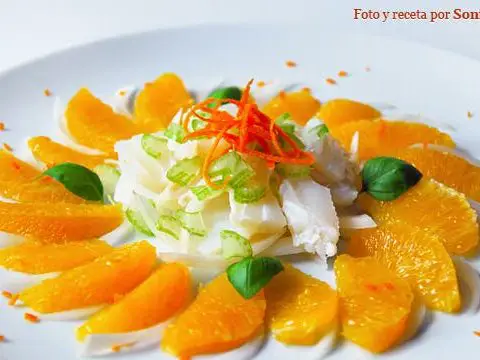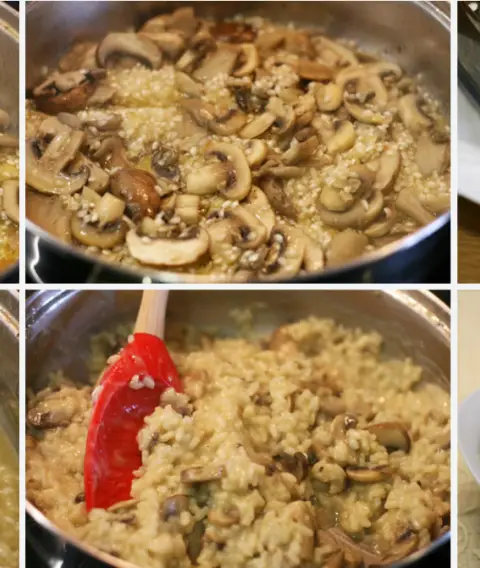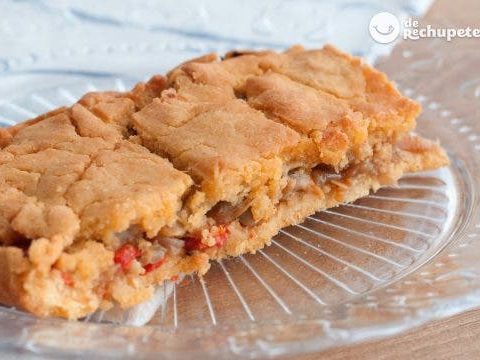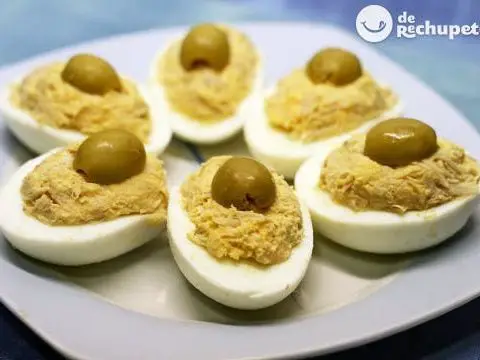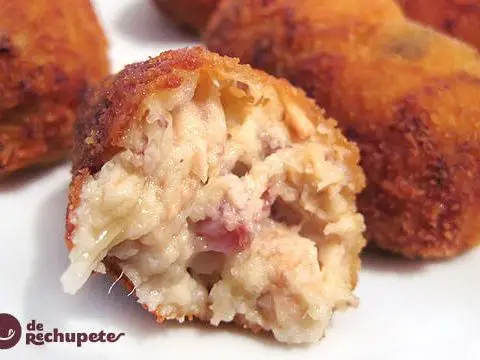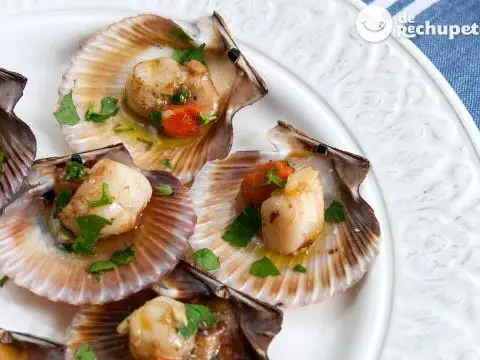
Info.
- Hard
- 90 minutes
- For 8 people
- 1.8 € / person
When one thinks of Galician empanada one thinks of the typical tuna or meat . But I assure you that there is a whole world beyond and a clear example is this Galician chicken empanada marinated in soy and honey, mushrooms, raisins and mousse de foie , a recipe that combines traditional and exotic flavors with the delicacy of mousse de foie . A different empanada, one of those that I call “let’s see what comes out” and that surprise by how good they are. Remember that with what you have on hand the pie will come out yummy, of course.
This is a fusion recipe between Galician and Asian cuisine, mixing spicy chicken with the sweet touch of grapes and foie. You already know that Galicia is famous for its ingredients, we have a select offer in fish and seafood, splendid meats and vegetables.
We made this empanada in a xuntaza of friends as a course-dinner at home. In times of crisis it is convenient to be creative with leisure and spend as little as possible, one option is to practice updated barter. I taught how to make Galician empanada, Mery teaches us how to make Moroccan pastries or pastilles and some gin and tonics that you die, Omar gave him the cocktails (he makes a glorious White Russian), Clara brings her marshmallow and chocolate cake … mother I’m so hungry! Little by little I will upload the recipes, they would give to update the blog for several weeks. And is that everyone has something that can teach others, and you too. I am eager that you send me your recipes, those that you make with your grandmother or your mother, together we will ensure that this recipe is not lost, share it without mercy.
Preparation of the compango: Maceration and mixing.
The fundamental thing for this recipe to be a success is the quality of the ingredients, on the one hand the bread dough and on the other that the best that is at hand is used in the filling or compango. I used chicken breast chosen and recommended expressly by the butcher, an authentic quality soy sauce, Galician honey, raisins from a Moroccan store, selected mushrooms (we can substitute them for seasonal mushrooms), a good extra virgin olive oil, flour of strength of the Amasadero, onions and mousse of foie (within reach of any mortal, since the authentic foie we are going to leave it for Christmas).
- Chicken breast, which to many seems dry, can be turned into a delicacy with a small maceration the day before of soy sauce, salt, freshly ground black pepper and a few tablespoons of Galician honey. If you leave all these ingredients with the 2 cm pieces of chicken in a tupper overnight in the fridge you will get to give the chicken an incredible flavor, 10 points to the filling of your Galician empanada.
- For the compango base we will need a lot of onion. Among the great variety of onions I used the variety of white and sweet onion, which accompanies honey and grapes. Put the extra virgin olive oil in a saucepan and when it is hot, add the 3 onions in a thin julienne, that is, in finite strips. We spend about 15 minutes over medium heat until they are transparent and poached. We remove from the casserole to a source and we already have the first layer of the pie. We remove the excess oil from poaching the onion to a glass, as we will use it for the dough.
- We soak the seedless raisins in a cup with a little water, in a few minutes you will see how they swell slightly, we reserve until the last step.
- We prepare the mushrooms, wash very well and cut into quarters. We are not going to laminate them because the mushroom will stay in the middle once we have cooked it and we want to find them in the filling. We reserve.
- Drain the chicken breasts and sauté without oil in a frying pan over high heat. The process should be round and round, no more than 1 minute per side. We also sauté the mushrooms and combine with the chicken and the previously drained raisins. Mix well with a spoon to bring together all the flavors of the filling.
- We let the filling cool to be able to add to the dough. On the one hand we have the onion on a plate and on the other hand all the compango or chicken filling. It is important to remove the excess oil to use it in the preparation of the dough and that the filling is juicy but not oily.
Preparation of the Galician empanada dough
We already have the compango or roast cooling, the excess oil in the glass and now we can already prepare the dough.
- In a large bowl we introduce part of the strength flour. We leave about 4 tablespoons to fatten the dough. In the center of the bowl, with a spoon we make a hole, and introduce the pressed baker’s yeast or 15 g of an envelope of baker’s baking powder dissolved in warm water.
- Beat with a wooden spoon from the center outwards and gradually mix with the flour.
- Add the oil from the sauce of the filling and the salt. We continue removing what begins to be the dough. For now it will be a sticky but firm mix. We prepare the area where we are going to knead, for example the kitchen counter is perfect. We fill the area of the counter with flour, remove the dough from the bowl and begin to work the dough with your hands.
- Little by little we can manipulate the dough more quickly, it will remain elastic and homogeneous. This process takes about 10 minutes. We are turning the dough into a ball. We take the previous bowl and flour it. We introduce the dumpling into it.
- We cover the bowl with a cotton cloth for an hour and wait for it to double in size. And that’s it, there we have the dough to start preparing the Galician empanada or the one that we like the most.
Preparation of chicken and foie pie:
- We divide the empanada dough into two similar parts. We knead the two balls again to be able to work well with them. We flour the kitchen counter and roll out the dough with the rolling pin. We make the base that will be the size of the baking tray. We will stretch it as thin as possible with the help of the roller, if you do not have one you can use a bottle that is clean. We put on the tray a piece of paper for baking or waxed and on top the base cutting the excess if needed.
- First add a layer of onion and on top we will put our chicken companion and mushrooms all over the base of the empanada without leaving a hole. It is very important that the filling is cold so that the dough holds up well. We finely laminate the foie mousse and strategically place the flakes so that when the inside of the filling is heated it melts. I have repeated this empanada several times and sometimes I substitute the foie for Arzúa-Ulloa cheese, ugh! Terrific.
- We cover with the other half well stretched and seal it by the edges, braiding the lower part over the upper one with the help of a fork or with the help of the fingers as Karen teaches us (you have a lot of photographs so you don’t get lost in this step) from right to left and then pressing. We make a small hole in the center for the empanada to which the chimney is called to breathe, where most of the steam that is created inside the empanada will come out, and with a fork we puncture through different areas, so it will not inflate. Garnish with strips or cords of the excess paste, to taste. Those freshly baked crisps are very rich.
- We paint the empanada with extra virgin olive oil with the help of a kitchen brush, without fear, it must be well impregnated.
- We preheat the oven at 180ºC for 5 minutes and then put the empanada at the same temperature, first in the bottom of the oven (about 20 minutes) and then another 15-20 minutes in the center. When it is golden brown, we remove it.
And finally the empanada! Be careful when removing it from the tray because it will still be hot and it is easy to break, cut it with a good pair of scissors or a serrated knife when it is warm. I can assure you that not even a few miserable faragullas (crumbs) Bon appetit!
I leave you with the photos of the step-by-step preparation of this pie, thanks to Karen and Mery for their invaluable work and for being such good students, the best thing about doing a course with friends is that then the party continues with a great cake and many G&T, s.
What yeast do I have to use to make the Empanada? What is baker’s yeast, pressed or fresh? Does Royal type yeast work?
Many of you always ask me this subject by email. When we use yeast for sourdoughs like bread, empanadas or buns, baker’s yeast is used , pressed or commonly called fresh . Baking yeast is a living, indispensable and fundamental product for bread making, it is the key ingredient that provides volume, fluffiness and an incomparable flavor.
It comes in the form of cubes, they are sold in supermarkets (I have bought it in Mercadona, Eroski or in Ahorra Más) in compact, crumbly and slightly moist 50 gr (2 × 25 g) taquitos. This dose is ideal for a quantity of flour of 1Kg.) You will find it in the section of refrigerated products (near the butters and creams). Ask the super employees and they will kindly indicate you in which zone it is. It is essential that once at home you store it in the refrigerator so that it preserves its properties between 3 ° and 8 ° C.
The one I usually use is from the LEVITAL brand. It is very easy to use, or we mix it with a little warm or lukewarm water that will help to better disperse the dough or crumble it with our fingers on top of the flour that we are going to use.
The yeast has the capacity to provide more flavor to the empanada since it allows the force flour to develop all its flavors. Yeast also contributes to the crisp, golden color of the crust. The main function is to transform sugar or starch (the main component of flour) into carbon dioxide and alcohol, which will evaporate during cooking. Carbon dioxide, a gas present in the air, is distributed throughout the mass and creates small air pockets that grow, giving volume to it.
Important: To make empanada dough you should not use Royal baking powder . This is a gasifying agent, different from yeast, they are chemical yeasts that only act during the baking phase so that the pie will not grow in either of the two fermentation phases.
